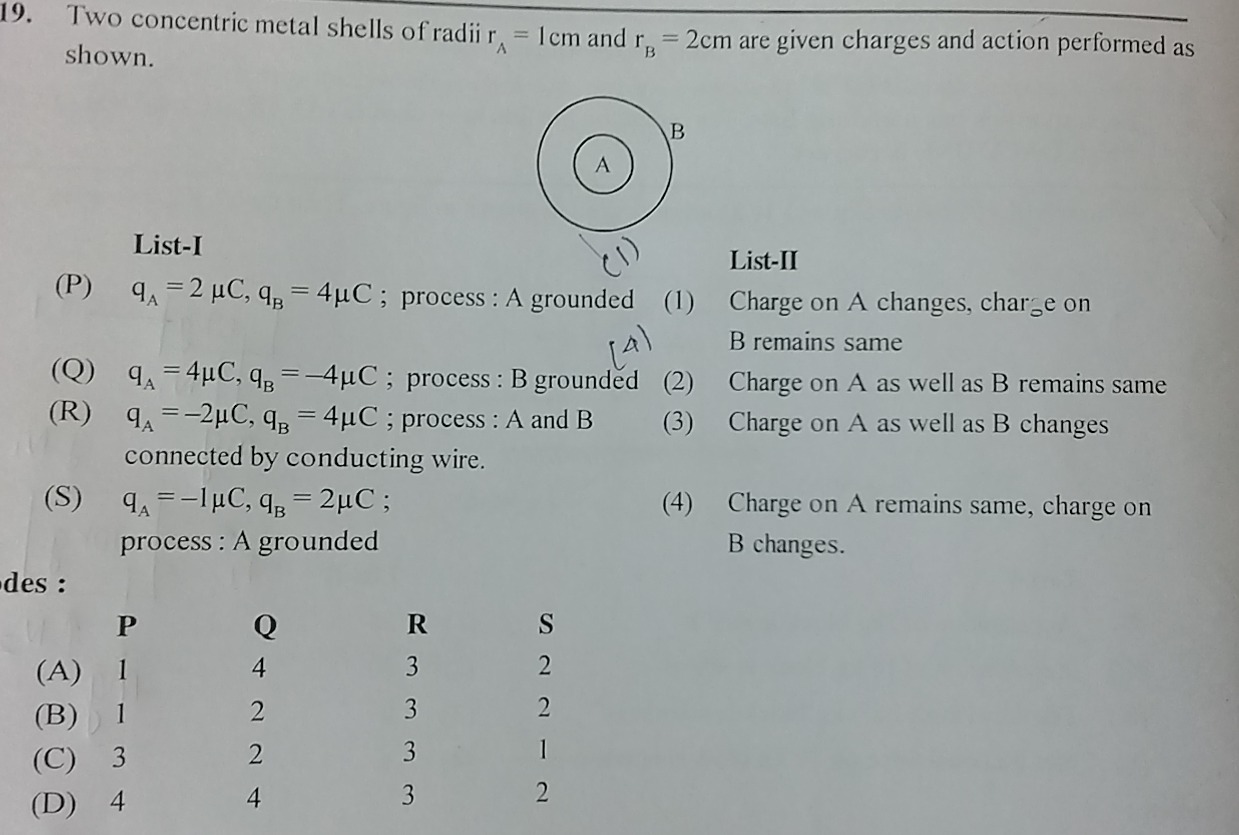Question
Question: Two concentric metal shells of radii $r_A = 1$ cm and $r_B = 2$ cm are given charges and action perf...
Two concentric metal shells of radii rA=1 cm and rB=2 cm are given charges and action performed as shown.

1 | 4 | 3 | 2
1 | 2 | 3 | 2
3 | 2 | 3 | 1
4 | 4 | 3 | 2
Option (B)
Solution
We must decide what happens when one of the shells is “grounded” or when the shells are connected. In our problem the two shells (inner A of radius 1 cm and outer B of radius 2 cm) carry the initial charges given in List–I. Then the following takes place:
-
For (P):
• Initial: q₍A₎ = 2 µC, q₍B₎ = 4 µC.
• Process: Shell A is grounded. Since A’s potential becomes zero, usingV₍A₎ = k (q₍A′₎/r₍A₎) + k (q₍B₎/r₍B₎) = 0
we get
q₍A′₎ = –(r₍A₎/r₍B₎) q₍B₎ = –(1/2)×4 = –2 µC.
Thus A’s charge changes while B remains unchanged. This is outcome type (1).
-
For (Q):
• Initial: q₍A₎ = 4 µC, q₍B₎ = –4 µC.
• Process: Shell B is grounded. For B we haveV₍B₎ = k [ (q₍A₎ + q₍B′₎)/r₍B₎ ] = 0 ⟹ q₍B′₎ = –q₍A₎ = –4 µC.
Because A is isolated it stays at 4 µC. So the net charges do not change; both shells remain with the same charges. This is outcome type (2).
-
For (R):
• Initial: q₍A₎ = –2 µC, q₍B₎ = 4 µC ⟹ Total Q = 2 µC.
• Process: A and B are connected by a conducting wire so they come to a common potential. For concentric spheres the potentials are given byq₍A′₎/r₍A₎ = q₍B′₎/r₍B₎
and
q₍A′₎ + q₍B′₎ = 2 µC.
Solving, we get
q₍A′₎ = 2/3 µC and q₍B′₎ = 4/3 µC.
Thus both charges change. This is outcome type (3).
-
For (S):
• Initial: q₍A₎ = –1 µC, q₍B₎ = 2 µC.
• Process: Shell A is grounded. Again usingV₍A₎ = k (q₍A′₎/r₍A₎) + k (q₍B₎/r₍B₎) = 0 ⟹ q₍A′₎ = –(r₍A₎/r₍B₎) q₍B₎ = –(1/2)×2 = –1 µC.
So A remains at –1 µC while B, being isolated, also keeps its net charge (2 µC). In other words the net change is nil; this outcome is like (2).
We then obtain the following matching:
(P) → (1)
(Q) → (2)
(R) → (3)
(S) → (2)
Checking the options given in List–II we see that Option (B) has the mapping:
P: 1, Q: 2, R: 3, S: 2.
Thus the correct answer is Option (B).
